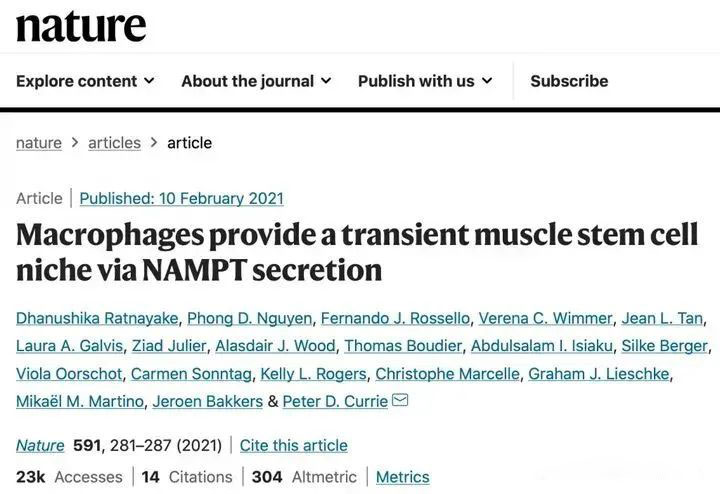
Scientists at Monash University in Melbourne, Australia, have shown that a specific type of immune cell can secrete NAMPT to stimulate the proliferation of muscle stem cells, allowing damaged muscle to be repaired and regenerated.
Advanced age is a scythe that hangs over the heads of all athletes waiting to be harvested. This is because no matter what age the body is at, muscles are always wearing out during exercise. In order to keep the muscles alive and strong in a young body, muscle stem cells exert their muscle regenerative powers to repair damaged muscles. However, as we age, these muscle stem cells gradually lose their ability to regenerate muscle. Once the muscle is overused or damaged, it is difficult to recover. Regenerating muscle stem cells is the key to repairing muscle damage.
1. Macrophages secrete NAMPT, a synthetic enzyme of NMN
An article published in Nature by Dr Ratnayake's team at Monash University in Melbourne, Australia, has revealed a means of triggering muscle stem cell regeneration to heal muscle damage. The researchers found that macrophages (a type of immune cell that converges at sites of injury or infection in the body to remove debris and promote healing) can secrete the NMN synthase NAMPT (nicotinamide phosphoribosyltransferase) to stimulate muscle stem cell regeneration and restore their motility after severe muscle trauma. This significant discovery not only offers hope for athletes with frequent muscle injuries and tears to extend their professional life, but also for the elderly and those with severe muscle diseases.

2. Zebrafish experiment: NAMPT stimulates muscle stem cell regeneration
The researchers used zebrafish, a common model for studying cell regeneration, which has the advantages of rapid reproduction, sharing at least 70% of its genes with humans, and being transparent enough to allow observation of muscle regeneration in vivo.
The researchers observed that a specific type of macrophage gathered at the site of muscle damage in the zebrafish and 'embraced' the muscle stem cells, and once the muscle stem cells started to proliferate and regenerate, these macrophages continued to 'embrace' the muscle stem cells. Once the muscle stem cells had started to proliferate and regenerate, these macrophages would go on to 'embrace' the next muscle stem cell, initiating muscle stem cell regeneration, and the muscle wound would soon be healed.
The researchers then determined that macrophages secrete a protein called nicotinamide phosphoribosyltransferase (NAMPT), an enzyme essential for NAD+ metabolism that catalyses the production of nicotinamide mononucleotides (NMN), at the site of muscle damage. When the researchers genetically manipulated these macrophages to be unable to secrete NAMPT, they observed that the macrophages "embraced" the muscle stem cells but were unable to initiate muscle regeneration. However, when human-secreted NAMPT was added to the zebrafish tank, the muscle regeneration response was restored. This suggests that NAMPT is required for muscle regeneration in zebrafish.
3. Experiments in adult mice: NAMPT promotes wound repair and restores muscle structure in mice with acute muscle damage
The researchers used mice with severe rectus femoris muscle injury as subjects and treated the muscle injury site with NAMPT hydrogel patch and control hydrogel patch (control group) for 10 days to explore whether human-secreted NAMPT could promote muscle regeneration in mice.
The results revealed a significant increase in muscle regeneration, a significant decrease in muscle fibrosis, and a significant increase in the total number of muscle stem cells and the number of proliferating and regenerating muscle stem cells in mice treated with NAMPT hydrogel compared to the control group. This suggests that in the case of acute muscle injury in adult mammals, supplementation with NAMPT stimulates muscle wound repair and allows for complete recovery of muscle structure.
This study shows that macrophages can send muscle stem cell-initiated signals, such as NAMPT, to serve as a means of treatment for skeletal muscle injury and disease. Providing the specific macrophage-derived signals required for muscle stem cell regeneration will provide new directions to achieve better muscle stem cell-based therapies.
In addition, NAMPT is an enzyme that is essential for NAD+ metabolism and its action is achieved through NMN. Numerous studies have now shown that NMN supplementation can increase NAD+ levels in the body, thereby delaying, improving and preventing many clinical signs associated with ageing, or age-induced metabolic disorders and age-related diseases.
Notably, NAD+ can affect the activity of the longevity protein SIRT1 at its own level, which in turn affects the expression of a range of related proteins, including NAMPT. Previous studies have also shown that NMN supplementation can increase mitochondrial metabolism and thus improve muscle function; the exact mechanism and the role of NAMPT in this requires further study.
Summary:
Exploring the effectiveness and safety of NAMPT and NMN to inhibit diseases such as ageing, muscle damage or atrophy will open up more possibilities for people who need to stay young. Perhaps one day athletes will no longer have to worry about their short careers, and senior citizens will still be able to do the sports they enjoyed when they were younger.
Age-inhibiting technologies such as NMN may lead the way to a future in which "always young and always in tears" becomes everyone's right.

Leave a Comment